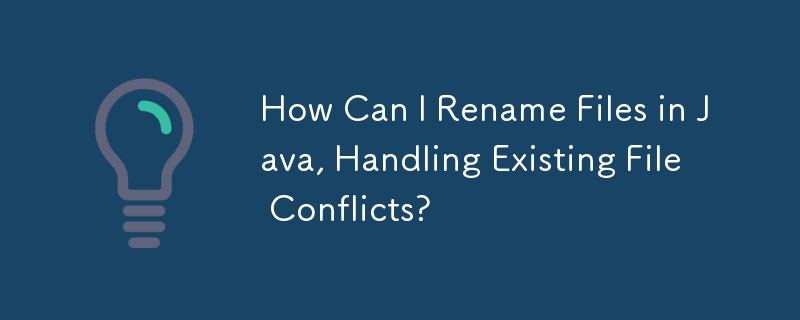Found a total of 10000 related content

PHP file read and write operations: read, process and write grade data
Article Introduction:This document details how to use PHP for file reading and writing operations, and demonstrates in a practical case how to read grades from grades.txt file, add 1 (maximum value is 5), then write processed grades to the results.txt file, and finally output these processed grades in the console. Through this article, you will master the basic methods of PHP file operation and learn how to process data in files.
2025-08-26
comment 0
866


In-depth analysis of C language file operation problems
Article Introduction:In-depth analysis of C language file operation problems Preface file operation is an important function in C language programming. However, it can also be a challenging area, especially when dealing with complex file structures. This article will deeply analyze common problems in C language file operation and provide practical cases to clarify solutions. When opening and closing a file, there are two main modes: r (read-only) and w (write-only). To open a file, you can use the fopen() function: FILE*fp=fopen("file.txt","r"); After opening the file, it must be closed after use to free the resource: fclose(fp); Reading and writing data can make
2025-04-04
comment 0
1128

C language file operation: How to close a file?
Article Introduction:C language file operation: How to close a file? Preface file operation is a very important topic in C language. After opening a file, it must be closed to free up system resources and ensure data integrity. This article will guide you how to close files in C language. Syntax To close a file, use the fclose() function. The syntax is as follows: intfclose(FILE*fp); where fp is the file pointer to be closed. Return value The fclose() function returns 0 to indicate successful closing of the file, otherwise it returns EOF (indicating the end file). Practical case: Read the file and close Let's write a C program, read data from the file and display it on the screen. The program also demonstrates
2025-04-04
comment 0
405


C language comprehensive understanding of file operations
Article Introduction:C language provides file operation functions, including opening, closing, reading, writing and moving file pointers. These functions support a variety of operations, such as reading data, writing data, and moving it in a file. Use fopen() and fclose() to open and close files, fread() and fwrite() can be used for data reading and writing, and fseek() allows users to move in files. These functions are widely used in practical applications, such as file copying.
2025-04-04
comment 0
460

How to Use the Symfony Filesystem Component
Article Introduction:This article explores Symfony's Filesystem component, a powerful tool for streamlined file system interactions in PHP applications. We'll cover installation, configuration, and practical examples.
Why Use the Symfony Filesystem Component?
PHP develo
2025-03-01
comment 0
471

How to read, sort and overwrite text file content in Go
Article Introduction:This article details how to use Go language to efficiently read text file content, store each line of data into a string slice, and then use the sorting function of the Go standard library to sort these lines alphabetically, and finally write the sorted content back to the original file. The tutorial provides clear function implementation and complete sample code to help developers master practical skills in file operation and data processing.
2025-08-21
comment 0
335


No file operation in PHP implements attachment sending and data storage
Article Introduction:This tutorial explains in detail how to avoid creating temporary files in PHP and directly process Base64-encoded PDF data through memory operations. We will explore how to extract Base64 strings from XML, decode them and send mail via SendGrid as attachments, while storing the original Base64 data to the database, improving security, performance and simplifying code.
2025-08-24
comment 0
712

What is a file system library in C 17?
Article Introduction:The C 17 file system library provides a unified, type-safe interface, making file and directory operations more intuitive and efficient. 1) The std::filesystem::path class simplifies path operation; 2) The std::filesystem::directory_iterator facilitates traversing directories; 3) Pay attention to exception handling and performance optimization to ensure the robustness and efficiency of the program.
2025-04-28
comment 0
1054

How to Convert Time and Date Across Time Zones in PHP?
Article Introduction:This article presents a PHP class for time zone conversions, addressing the need to manipulate and convert timestamps across different time zones. It covers GMT time offset retrieval, Daylight Saving Time considerations, and provides a practical impl
2024-10-23
comment 0
1068

PHP gets a list of directory files and uses it in JavaScript
Article Introduction:This article will introduce how to use PHP to obtain the file names of all files in a specified directory and pass these file names into JavaScript code as an array. Read the directory through PHP's file operation function, then convert the PHP array into a JSON string using the json_encode function, and finally parse the JSON string in JavaScript, thereby realizing the passing and use of file names.
2025-08-21
comment 0
879

MongoDB large batch JSON file import: using mongoimport with batch scripts
Article Introduction:This tutorial details how to efficiently import large amounts of JSON files into a MongoDB database. For scenarios with tens of thousands of JSON file paths, the article provides a practical solution: generate mongoimport commands for each file through scripts and summarize them into a batch file for execution. This method avoids the cumbersome manual operation and ensures batch and sequential import of data. It is suitable for scenarios where structured data in the local file system needs to be loaded into MongoDB quickly. It is an effective strategy for handling large-scale data import tasks.
2025-08-06
comment 0
588

How to Extract Specific CSS Classes with PHP?
Article Introduction:Parsing CSS with PHP for Selective Class ExtractionIn this article, we aim to tackle the challenge of parsing a CSS file and extracting specific...
2024-11-15
comment 0
975

A Tour of PHP.INI
Article Introduction:Detailed explanation of PHP.ini file: The key to controlling PHP operation
The PHP.ini file is the core configuration file of the PHP server. It controls various parameter settings during PHP runtime, such as uploading directories, error logs, maximum script execution time, and file upload size limit. After modifying this file, you need to restart the server before the changes can take effect.
php.ini file location:
The location of the php.ini file varies depending on the server and how PHP is installed. You can use the phpinfo() function to find its location.
Key settings:
This article will focus on some important php.ini settings:
engine = On: Enable or disable the PHP engine. Setting it to Off will completely
2025-03-02
comment 0
923

What is the role of spl_autoload_register() in PHP's class autoloading mechanism?
Article Introduction:spl_autoload_register() is a core function used in PHP to implement automatic class loading. It allows developers to define one or more callback functions. When a program tries to use undefined classes, PHP will automatically call these functions to load the corresponding class file. Its main function is to avoid manually introducing class files and improve code organization and maintainability. Use method is to define a function that receives the class name as a parameter, and register the function through spl_autoload_register(), such as functionmyAutoloader($class){require_once'classes/'.$class.'.php';}spl_
2025-06-09
comment 0
413

PHP gets a list of directory files and uses it in JavaScript
Article Introduction:This article will introduce how to use PHP to read all file names in a specified directory and pass these file names to JavaScript code for use. Through PHP's file operation functions and JSON encoding, we can easily obtain file lists on the server and use JavaScript to further process them on the client, such as dynamically displaying file lists or performing other related operations.
2025-08-21
comment 0
812



















